One of the films presented at the Le Giornate del Cinema Muto is I promessi sposi/The Betrothed (Eleuterio Rodolfi, 1913). The early silent production of the Ambrosio company was welcomed in the US as ‘entirely worthy to be enrolled in the list of the world’s moving picture classics’. It is one of the many film adaptations of I promessi sposi by Alessandro Manzoni. This Italian historical novel belongs to the most famous and widely read books of the Italian language.
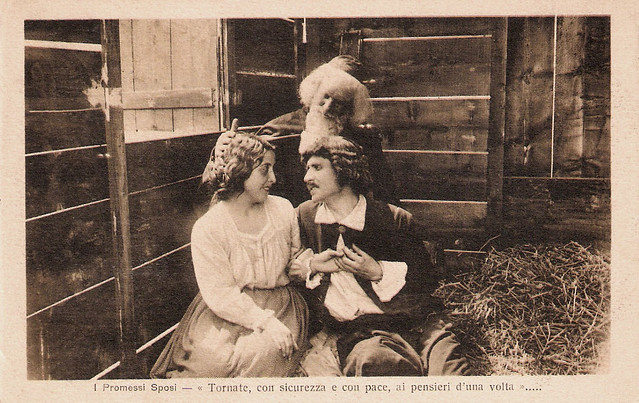
Italian postcard by IPA/CT, no. 1665. Photo: Film Soc. An. Ambrosio, Torino. Caption: Tornate, con sicurezza e con pace, ai pensieri d'una volta. (Return, safely and peacefully, to the thoughts of long ago).
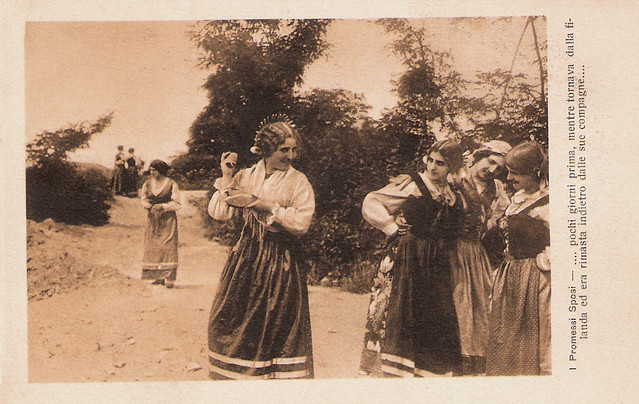
Italian postcard by IPA/CT. Photo: Film Soc. An. Ambrosio, Torino. Caption: ... pochi giorni prima, mentre tornava dalla filanda ed era rimasta indietro dalle sue compagne.... (...a few days before, while returning from the cotton mill, and left behind by her companions...).
The idea for the novel came to Alessandro Manzoni (1783 – 1873) in 1821, from something he saw in a book he took on holiday with him to Brusuglio. This was an edict from the year 1627, which specified penalties for any priest who refused to perform a marriage. More material came from Giuseppe Ripamonti's Milanese Chronicles.
Manzoni’s first version, Fermo e Lucia, was written between April 1821 and September 1823. It was heavily revised, and finished in August 1825. Corrections and proof-checking took two years.
The original title, Gli sposi promessi, was changed for the sake of euphony shortly before its publication in three volumes in 1827.
In the early 19th century, there was still some controversy as to what form the standard literary language of Italy should take.
Manzoni was firmly in favor of the dialect of Florence and, after washing his vocabulary on the banks of the Arno (as he put it), he revised the novel for its republication in 1842.
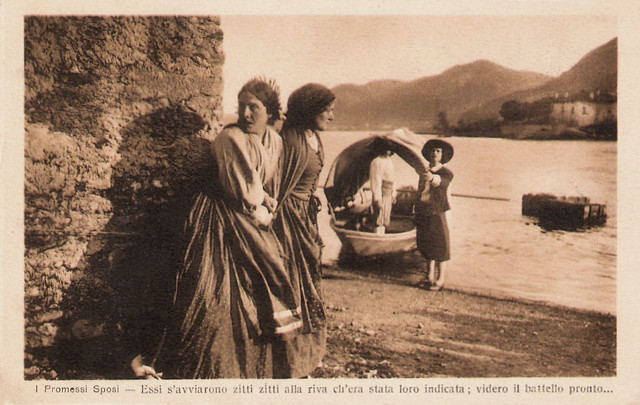
Italian postcard by IPA/CT, no. 1654. Photo: Film Soc. An. Ambrosio, Torino. Caption: Essi s'avviarono zitti zitti alla riva ch'era stata loro indicata; videro il battello pronto... (Very quietly, they walked to the shore which had been indicated to them, and they saw the boat ready for them ...).
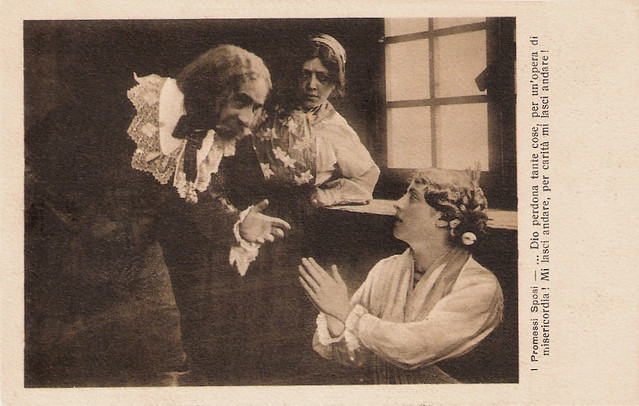
Italian postcard by IPA/CT, no. 1658. Photo: Film Soc. An. Ambrosio, Torino. Caption: ... Dio perdona tante cose, per un'opera di misericordia! Mi lasci andare, per carità mi lasci andare! (... God forgives so many things, for an act of compassion! Let me go, for heaven's sake let me go!).
I Promessi Sposi was inspired by Walter Scott's Ivanhoe and was the first Italian historical novel. It deals with a variety of themes, from the cowardly, hypocritical nature of a priest (Don Abbondio) and the heroic sainthood of others (Padre Cristoforo, Federico Borromeo), to the unwavering strength of love (the relationship between Renzo and Lucia and the struggle of these betrothed to finally meet again and get married), and offers some keen insights into the meanderings of the human mind.
The middle of the 19th century was a turbulent period in Italy (it was the time of the Risorgimento, the Italian unification) and the literature was used as a means to express opinions about the state, society and religion.
I promessi sposi is considered the most representative document from the time of the Risorgimento and Romanticism. Moreover, it is considered one of the highlights of Italian literature and virtually every high school student in Italy read the book at school.
Regarding the structure is the first modern novel in Italian literary history and also has a major influence on the national Italian language. The book describes the Italy of the seventeenth century, during the Spanish occupation of the country. This can be seen as a message to the Austrians, who at the time of publication of the book Italy prevailed. Famous is also the description of the plague which broke out around 1630 in Milan.
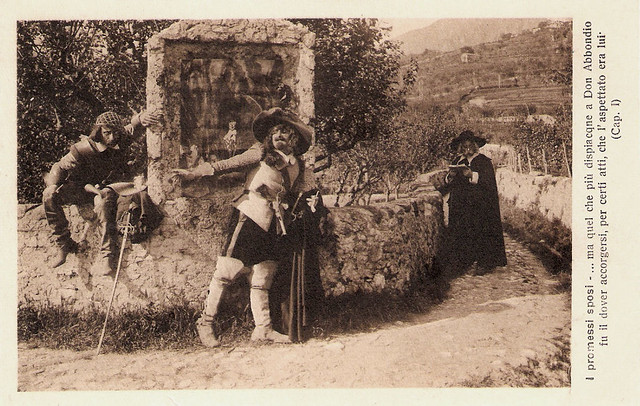
Italian postcard by Film Soc. An. Ambrosio, Torino, no. 1642. Caption: ...ma quel che pìu dispiacqne a Don Abbondio fu il dover accorgersi, per certi atti, che l'aspettato era lui. (... but what would most displease Don Abbondio, was that he had to discover by certain acts, that he was the one they were awaiting for...) (Chapter 1).

Italian postcard by Film Soc. An. Ambrosio, Torino, no. 1649. Caption: ...pochi giorni prima, mentre tornava dalla filanda, ed era rimasta indietro dalla sue compagne, le era passato innanzi Don Rodrigo, in compagnia di un altro signore.... (... a few days before, while returning from the mill, and left behind by her companions, before her passed Don Rodrigo, in the company of another gentleman...) (Chapter 3).
Lorenzo Tramaglino, or Renzo is a young silk-weaver of humble origins. He is engaged to Lucia Mondella is a pious and kind young woman. They live in a village near Lake Como in 1628.
The parish priest, Don Abbondio, is walking home on the previous evening when he is met by a pair of ‘bravoes’ (thugs) who tell him he is not to perform the marriage of Renzo and Lucia, as the local baron (Don Rodrigo) forbids it. The next day, Renzo is amazed when he turns up at Don Abbondio's home to hear that the marriage is to be postponed (he didn't have the courage to tell the truth). A long argument ensues and Renzo succeeds in extracting from the priest the name of Don Rodrigo.
It turns out that Don Rodrigo has his eye on Lucia. Lucia's mother, Agnese, advises Renzo to ask the advice of Dr. Azzeccagarbugli (Dr. Quibble-weaver), a lawyer in the town of Lecco. Dr Azzeccagarbugli is at first sympathetic, showing Renzo a recent edict on the subject of priests who refuse to marry, but when he hears the name of Don Rodrigo he panics and drives Renzo away.
Lucia sends a message to Fra Cristoforo (Friar Christopher), a respected Capuchin friar at the monastery of Pescarenico, asking him to come as soon as he can. At dawn, Fra Cristoforo comes to Lucia's cottage and hears the story. He immediately leaves for Don Rodrigo's mansion, where he finds the baron at a meal with his cousin Count Attilio, along with four guests, including the mayor and Dr Azzeccagarbugli. When Don Rodrigo is taken aside by the friar, he explodes with anger at his presumption and sends him away, but not before an old servant has a chance to offer him help.
Meanwhile, Agnese comes up with a plan. In those days, it was possible for two people to marry by declaring themselves married before a priest and in the presence of two amenable witnesses. Renzo runs to his friend Tonio and offers him 25 lire if he agrees to help. When Fra Cristoforo returns with the bad news, they decide to put their plan into action.
The next morning, Lucia and Agnese are visited by beggars who are, in fact, Don Rodrigo's men in disguise. They are examining the house in order to plan an assault. Late at night, Agnese distracts Don Abbondio's servant Perpetua while Tonio and his brother Gervaso enter Don Abbondio's study, ostensibly to pay a debt. They are followed indoors secretly by Lucia and Renzo. When they try to carry out their plan, the priest throws the tablecloth in Lucia's face and drops the lamp. They struggle in the darkness.
In the meantime, Don Rodrigo's men invade Lucia's house, but nobody is there. A boy named Menico arrives with a message of warning from Fra Cristoforo and they seize him. When they hear the alarm being raised by the sacristan, who is calling for help on the part of Don Abbondio who raised the alarm of invaders in his home, they assume they have been betrayed and flee in confusion.
Menico sees Agnese, Lucia and Renzo in the street and warns them not to return home. They go to the monastery, where Fra Cristoforo gives Renzo a letter of introduction to a certain friar at Milan, and another letter to the two women, to organise a refuge at a convent in the nearby city of Monza.
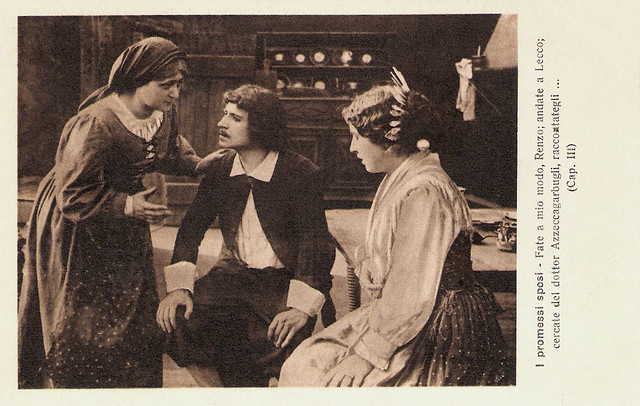
Italian postcard by Film Soc. An. Ambrosio, Torino, no. 1645. Caption: Fate a mio modo, Renzo; andate a Lecco; cercate del dottor Azzeccagarbugli, raccontategli... (Do it my way, Renzo; go to Lecco,find Dr Quibble-weaver, tell him ...) (Chapter 3).
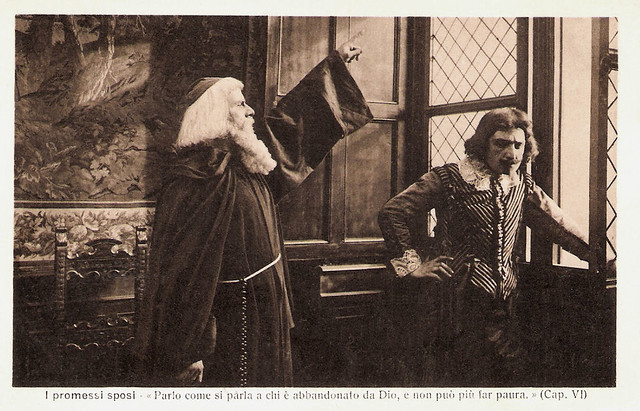
Italian postcard by Film Soc. An. Ambrosio, Torino, no. 1650. Caption: Parlo come si parla a chi è abbandonato da Dio, e non può più far paura. (I speak as one ought to speak to him who is abandoned by God, and can no longer frighten.) (Chapter 7).
Lucia is entrusted to the nun Gertrude, a strange and unpredictable noblewoman whose story is told in these chapters. A child of the most important family of the area, her father decided to send her to the cloisters for no other reason than to simplify his affairs: he wished to keep his properties united for his first-born, heir to the family's title and riches. As she grew up, she sensed that she was being forced by her parents into a life which would comport but little with her personality. However, fear of scandal, as well as maneuvers and menaces from her father, induced Gertrude to lie to her interviewers in order to enter the convent of Monza, where she was received as la Signora (the lady).
Later, she fell under the spell of a young man of no scruples, associated with the worst baron of that time, the Innominato (the Unnamed). La Monaca di Monza (the Nun of Monza) was based on a historical character. Renzo arrives in famine-stricken Milan and goes to the monastery, but the friar he is seeking is absent and so he wanders further into the city. A bakery in the Corsia de' Servi, El prestin di scansc (Bakery of the Crutches), is destroyed by a rabble, which then goes to the house of the Commissioner of Supply in order to lynch him. He is saved in the nick of time by Ferrer, the Grand Chancellor, who arrives in a coach and announces he is taking the Commissioner to prison.
Renzo becomes prominent as he helps Ferrer make his way through the crowd. After witnessing these scenes, Renzo joins in a lively discussion and reveals views which attract the notice of a police agent in search of a scapegoat. The agent tries to lead Renzo directly to ´the best inn´ (the prison) but Renzo is tired and stops at one nearby where, after being plied with drink, he reveals his full name and address.
The next morning, he is awakened by a notary and two bailiffs, who handcuff him and start to take him away. In the street Renzo announces loudly that he is being punished for his heroism the day before and, with the aid of sympathetic onlookers, he effects his escape. Leaving the city by the same gate through which he entered, he sets off for Bergamo, knowing that his cousin Bortolo lives in a village nearby. Once there, he will be beyond the reach of the authorities of Milan (under Spanish domination), as Bergamo is territory of the Most Serene Republic of Venice.
At an inn in Gorgonzola, he overhears a conversation which makes it clear to him how much trouble he is in and so he walks all night until he reaches the River Adda. After a short sleep in a hut, he crosses the river at dawn in the boat of a fisherman and makes his way to his cousin's house, where he is welcomed as a silk-weaver under the pseudonym of Antonio Rivolta. The same day, orders for Renzo's arrest reach the town of Lecco, to the delight of Don Rodrigo.
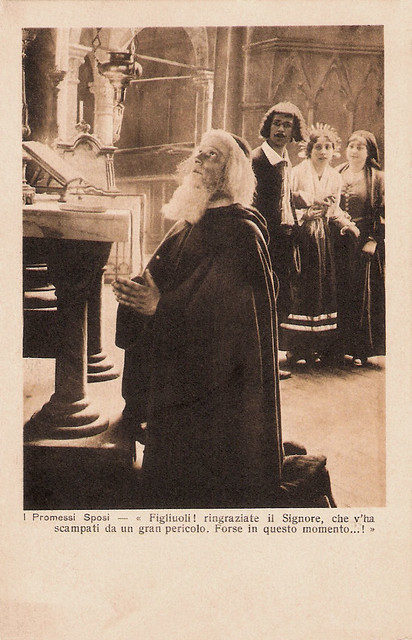
Italian postcard by IPA/CT, no. 1653. Photo: Film Soc. An. Ambrosio, Torino. Caption: Figliuoli! ringraziate il Signore, che v'ha scampati da un gran pericolo. Forse in questo momento...! (My children! Thank the Lord that he has saved you from a great danger. Perhaps at this moment ...!) (Chapter 8).
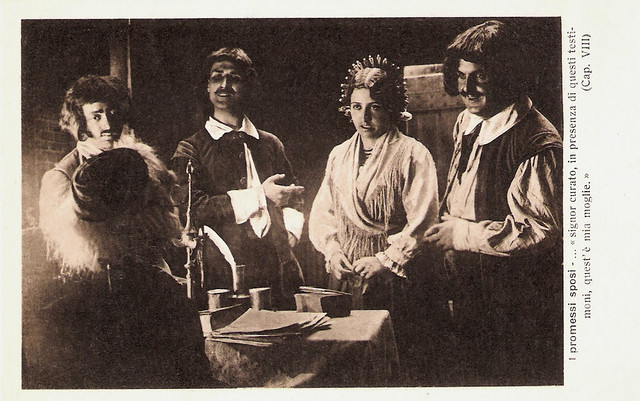
Italian postcard by Film Soc. An. Ambrosio, Torino, no. 1647. Caption: signor curato, in presenza di questi testimoni, quest'è mia moglie. (Father, in the presence of these witnesses, this is my wife..) (Chapter 8).
News of Renzo's disgrace comes to the convent, but later Lucia is informed that Renzo is safe with his cousin. Their reassurance is short-lived: when they receive no word from Fra Cristoforo for a long time, Agnese travels to Pescarenico, where she learns that he has been ordered by a superior to the town of Rimini. In fact, this has been engineered by Don Rodrigo and Count Attilio, who have leaned on a mutual uncle of the Secret Council, who has leaned on the Father Provincial.
Meanwhile, Don Rodrigo has organized a plot to kidnap Lucia from the convent. This involves a very great robber baron whose name has not been recorded, and who hence is called l'Innominato, the Unnamed.
Gertrude, blackmailed by Egidio, a male neighbour (and acquaintance of l'Innominato) whose attentions she has returned, persuades Lucia to run an errand which will take her outside the convent for a short while. In the street Lucia is seized and bundled into a coach.
After a nightmarish journey, Lucia arrives at the castle of the Unnamed, where she is locked up in a chamber. The Unnamed is troubled by the sight of her, and spends a horrible night in which memories of his past and the uncertainty of his future almost drive him to suicide.
Meanwhile, Lucia spends a similarly restless night, during which she vows to take the veil if she is delivered from her predicament. Towards the morning, on looking out of his window, the Unnamed sees throngs of people walking past. They are going to listen to the famous Archbishop of Milan, Cardinal Federigo Borromeo.
On impulse, the Unnamed leaves his castle in order to meet this man. This meeting prompts a ´miraculous´ conversion which marks the turning-point of the novel. The Unnamed announces to his men that his reign of terror is over. He decides to take Lucia back to her native land under his own protection, and with the help of the archbishop the deed is done.
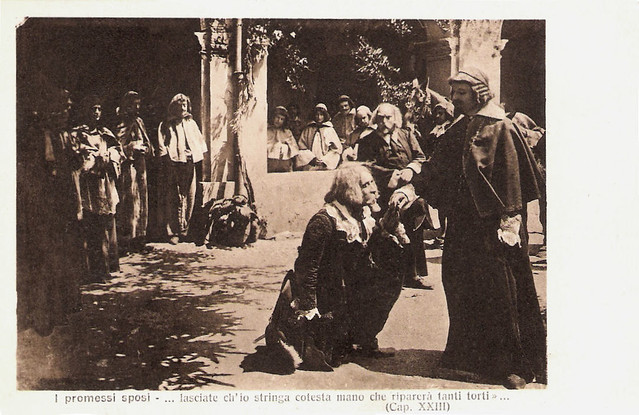
Italian postcard by Film Soc. An. Ambrosio, Torino, no. 1659. Caption: ...lasciate ch'io stringa cotesta mano che riparera tanti torti. (...permit me to press this hand which will repair so many wrongs....) (Chapter 23).
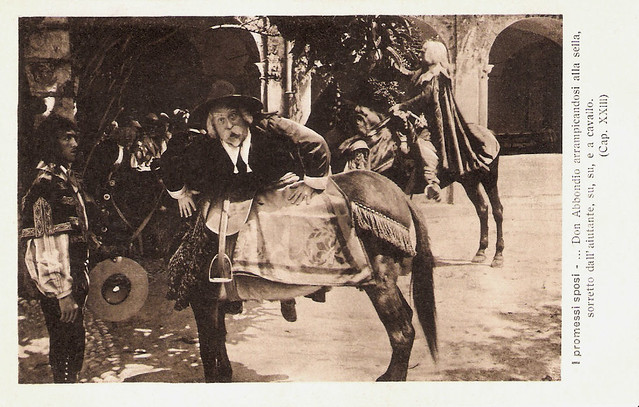
Italian postcard by Film Soc. An. Ambrosio, Torino, no. 1662. Caption: Don Abbondio arrampicandosi alla sella, sorretto dall' aiutante, su, su, e a cavallo. (Don Abbondio climbed onto the saddle, helped by his aid, slowly, slowly, he mounted the horse.) (Chapter 23).
The astonishing course of events leads to an atmosphere in which Don Rodrigo can be defied openly and his fortunes take a turn for the worse. Don Abbondio is reprimanded by the archbishop. Lucia, miserable about her vow to renounce Renzo, still frets about him. He is now the subject of diplomatic conflict between Milan and Bergamo. Her life is not improved when a wealthy busybody, Donna Prassede, insists on taking her into her household and admonishing her for getting mixed up with a good-for-nothing like Renzo.
The government of Milan is unable to keep bread prices down by decree and the city is swamped by beggars. The lazzaretto is filled with the hungry and sick. Meanwhile the Thirty Years War brings more calamities. In 1629, German armies under Count Rambaldo di Collalto descend into Italy, looting and destroying. Agnese, Don Abbondio and Perpetua take refuge in the well-defended territory of the Unnamed.
In their absence, their village is wrecked by the mercenaries. Then there are chapters with an account of the plague of 1630, largely based on Giuseppe Ripamonti's De peste quae fuit anno 1630 (published in 1640). Manzoni's full version of this, Storia della Colonna Infame, was finished in 1829, but was not published until it was included as an appendix to the revised edition of 1842.
The end of August 1630 sees the death in Milan of the original villains of the story. Renzo, troubled by Agnese's letters and recovering from plague, returns to his native village to find that many of the inhabitants are dead and that his house and vineyard have been destroyed. The warrant, and Don Rodrigo, are forgotten.
Tonio tells him that Lucia is in Milan. On his arrival in Milan, Renzo is astonished at the state of the city. His highland clothes invite suspicion that he is an 'anointer'; that is, a foreign agent deliberately spreading plague in some way. He learns that Lucia is now languishing at the lazzaretto, along with 16,000 other victims of the plague.
But in fact, Lucia is already recuperating. Renzo and Lucia are reunited by Fra Cristoforo, but only after Renzo first visits and forgives the dying Don Rodrigo. The friar absolves her of her vow of celibacy. Renzo walks through a rainstorm to see Agnese at the village of Pasturo. When they all return to their native village, Lucia and Renzo are finally married by Don Abbondio and the couple make a fresh start at a silk-mill at the gates of Bergamo.
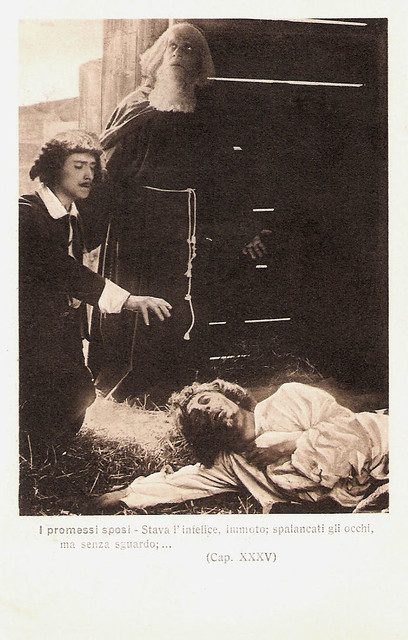
Italian postcard by Film Soc. An. Ambrosio, Torino, no. 1664. Caption: Stava l'infelice, immoto; spalancati gli occhi, ma senza sguardo;... (There the miserable was, motionless; his eyes were wide open, but unseeing; ... .) (Chapter 35).
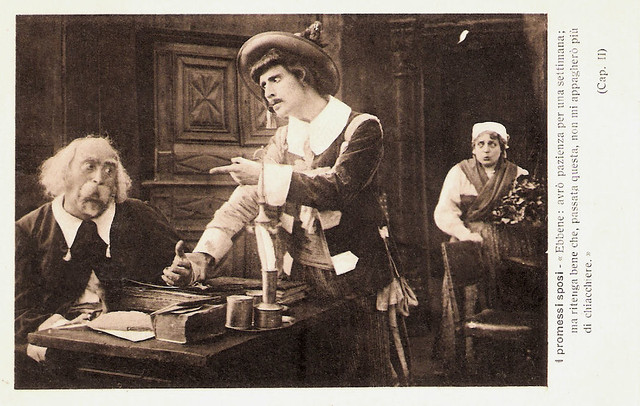
Italian postcard by Film Soc. An. Ambrosio, Torino, no. 1643. Caption: Ebbene: avrò pazienza per una settimana; ma ritenga bene che, passata questa, non mi appagherò più di chiacchiere. (Alright, I will have patience for one week. But remember, when this week has passed I will not stand this nonsense anymore.) (Chapter 2).
The postcards in this post were all produced for the Ambrosio version, I promessi sposi (Eleuterio Rodolfi, 1913), which premiered in September 1913. Ambrosio was one of the major production houses of the early Italian cinema. It was particularly renowned for quality literary adaptations, such as the super epic Gli ultimi giorni di Pompei/The Last Days of Pompeii (Arturo Ambrosio, Luigi Maggi, 1908) and seven films based on the novels of Gabriele D’Annunzio in 1911 and 1912.
Their version starred Gigetta Morano as Lucia and Mario Voller-Buzzi as Renzo. The other actors included Ersilia Scalpellini (Agnese), Bianca Schinini (Perpetua), Umberto Scalpellini (Don Abbondio), Eugenia Tettoni (the Nun of Monza), Antonio Grisanti (the Innominato), Cesare Zocchi (Fra Cristoforo), Luigi Chiesa (Don Abbondio) and Edoardo Rivalta (Cardinal Borromeo).
When the film was shown in the US in 1913, W. Stephen Bush wrote in The Moving Picture World: ”Something of the charm of Manzoni’s genius gets on the screen and casts a spell on the spectator. It is very evident that this was a labor of love with the Ambrosio company. To begin with, they have gone to the trouble of taking various scenes of the story on the various spots where Manzoni has located them, and we get glimpses of Lake Como set like a gem in one of the most beautiful landscapes of the world. The charm in the story lies in the fact that it deals with the adventures of a young couple from the ranks of the plain people of Italy.
Their simple honesty is set in striking contrast with the corruption and magnificence of the noble rulers of the country. (…) The producer has improved to the utmost every opportunity for spectacular work. The insurrection and the bread riots in Milan and later the fearful scenes in the deserted streets when the plague wept over the city, are portrayed with imposing skill and fidelity to life and history. The Betroyed by the Ambrosio Company is entirely worthy to be enrolled in the list of the world’s moving picture classics.”
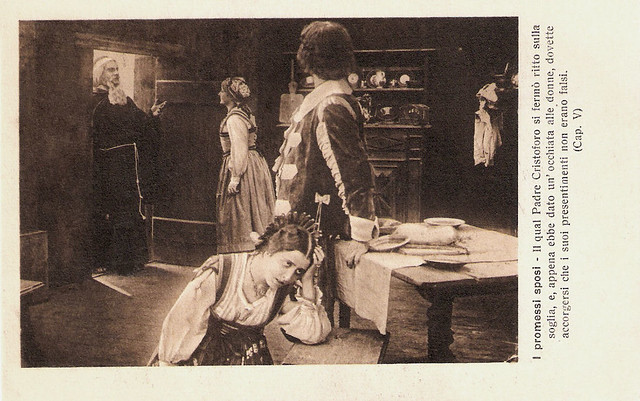
Italian postcard by Film Soc. An. Ambrosio, Torino, no. 1646. Caption: Il qual Padre Cristoforo si fermò ritto sulla soglia, e, appena ebbe dato un'occhiata alle donne, dovette accorgersi che i suoi presentimenti non erano falsi. (Then Father Christopher stood in the doorway, and, as soon as he looked at the women, he had to realize that his premonitions were not false.) (Chapter 5).
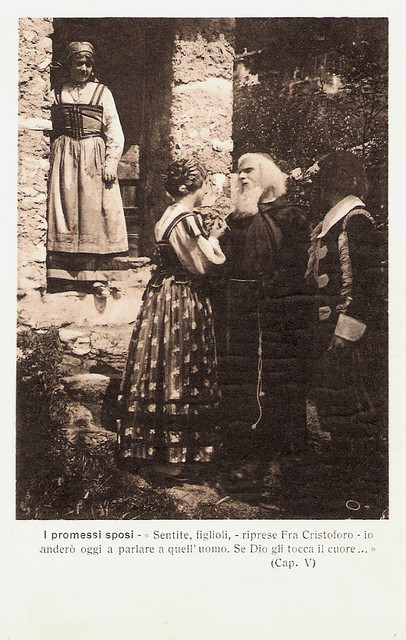
Italian postcard by Film Soc. An. Ambrosio, Torino, no. 1652. Caption: Sentite, figlioli, - riprese Fra Cristoforo - io anderò oggi a parlare a quell' uomo. Se Dio gli tocca il cuore... (Listen, children, - father Cristoforo answered - I will go and speak to that man today. If God touches his heart ....) (Chapter 5).
I promessi sposi was made into an opera of the same name by Amilcare Ponchielli in 1856 and by Errico Petrella in 1869.
There have been many film versions, all made in Italy. The first silent adaptation was I Promessi Sposi (Mario Mareis, 1908).
In 1913 there were two competing versions: film company Pasquali from Torino (Turin) made the one version, I promessi sposi (Ubaldo Maria Del Colle, 1913), and the other version I promessi sposi (Eleuterio Rodolfi, 1913) was produced by film company Ambrosio from the same city. Turin was the capital of the early Italian film industry.
Nine years later followed another silent adaptation: I promessi sposi (Mario Bonnard, 1922). The first sound version was I promessi sposi/The Spirit and the Flesh (Mario Camerini, 1941) starring Gino Cervi as Renzo. Then there was a Spanish-Italian version I Promessi Sposi (Mario Maffei, 1964), starring Gil Vidal and Maria Silva as Renzo and Lucia.
There were also various television versions. In 1967 Nino Castelnuovo starred as Renzo in the TV series I promessi sposi (Sandro Bolchi, 1967). Later followed the Italian-German-Yugoslavian TV series I promessi sposi (Salvatore Nocita, 1989) with an all-star cast including Danny Quinn, Alberto Sordi, Franco Nero, Helmut Berger and Burt Lancaster, and the TV film Renzo e Lucia/Renzo and Lucia (Francesca Archibugi, 2004) with Stefania Sandrelli as Agnese, Laura Morante as the Nun of Monza and Gottfried John as the Innominato.
There were also some parodies. Director Nanni Moretti made the comic Come parli, frate?/As you talk, brother (Nanni Moretti, 1974) and there was the TV miniseries I promessi Sposi (Massimo Lopez, Anna Marchesini, Tullio Solenghi, 1990) with Giuliano Gemma as El Gringo.
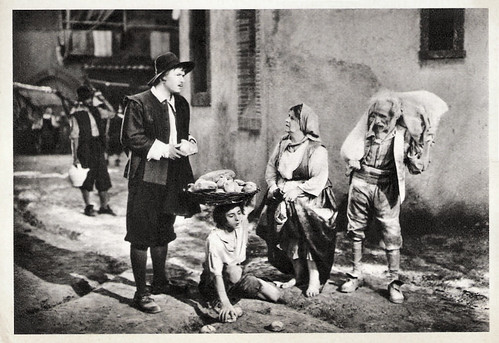
Italian postcard by S.A. Grafitalia, Milano (Milan), no. 10. Photo: Film Lux. Publicity still for I Promessi Sposi/The Spirit and the Flesh (Mario Camerini, 1941) starring Gino Cervi.
Sources: Aldo Bernardini/Vittorio Martinelli (Il Cinema Muto Italiano 1913), Gino Moliterno (The A to Z of Italian Cinema), Wikipedia, and IMDb.

Italian postcard by IPA/CT, no. 1665. Photo: Film Soc. An. Ambrosio, Torino. Caption: Tornate, con sicurezza e con pace, ai pensieri d'una volta. (Return, safely and peacefully, to the thoughts of long ago).

Italian postcard by IPA/CT. Photo: Film Soc. An. Ambrosio, Torino. Caption: ... pochi giorni prima, mentre tornava dalla filanda ed era rimasta indietro dalle sue compagne.... (...a few days before, while returning from the cotton mill, and left behind by her companions...).
For The Sake Of Euphony
The idea for the novel came to Alessandro Manzoni (1783 – 1873) in 1821, from something he saw in a book he took on holiday with him to Brusuglio. This was an edict from the year 1627, which specified penalties for any priest who refused to perform a marriage. More material came from Giuseppe Ripamonti's Milanese Chronicles.
Manzoni’s first version, Fermo e Lucia, was written between April 1821 and September 1823. It was heavily revised, and finished in August 1825. Corrections and proof-checking took two years.
The original title, Gli sposi promessi, was changed for the sake of euphony shortly before its publication in three volumes in 1827.
In the early 19th century, there was still some controversy as to what form the standard literary language of Italy should take.
Manzoni was firmly in favor of the dialect of Florence and, after washing his vocabulary on the banks of the Arno (as he put it), he revised the novel for its republication in 1842.

Italian postcard by IPA/CT, no. 1654. Photo: Film Soc. An. Ambrosio, Torino. Caption: Essi s'avviarono zitti zitti alla riva ch'era stata loro indicata; videro il battello pronto... (Very quietly, they walked to the shore which had been indicated to them, and they saw the boat ready for them ...).

Italian postcard by IPA/CT, no. 1658. Photo: Film Soc. An. Ambrosio, Torino. Caption: ... Dio perdona tante cose, per un'opera di misericordia! Mi lasci andare, per carità mi lasci andare! (... God forgives so many things, for an act of compassion! Let me go, for heaven's sake let me go!).
A Turbulent Period
I Promessi Sposi was inspired by Walter Scott's Ivanhoe and was the first Italian historical novel. It deals with a variety of themes, from the cowardly, hypocritical nature of a priest (Don Abbondio) and the heroic sainthood of others (Padre Cristoforo, Federico Borromeo), to the unwavering strength of love (the relationship between Renzo and Lucia and the struggle of these betrothed to finally meet again and get married), and offers some keen insights into the meanderings of the human mind.
The middle of the 19th century was a turbulent period in Italy (it was the time of the Risorgimento, the Italian unification) and the literature was used as a means to express opinions about the state, society and religion.
I promessi sposi is considered the most representative document from the time of the Risorgimento and Romanticism. Moreover, it is considered one of the highlights of Italian literature and virtually every high school student in Italy read the book at school.
Regarding the structure is the first modern novel in Italian literary history and also has a major influence on the national Italian language. The book describes the Italy of the seventeenth century, during the Spanish occupation of the country. This can be seen as a message to the Austrians, who at the time of publication of the book Italy prevailed. Famous is also the description of the plague which broke out around 1630 in Milan.

Italian postcard by Film Soc. An. Ambrosio, Torino, no. 1642. Caption: ...ma quel che pìu dispiacqne a Don Abbondio fu il dover accorgersi, per certi atti, che l'aspettato era lui. (... but what would most displease Don Abbondio, was that he had to discover by certain acts, that he was the one they were awaiting for...) (Chapter 1).

Italian postcard by Film Soc. An. Ambrosio, Torino, no. 1649. Caption: ...pochi giorni prima, mentre tornava dalla filanda, ed era rimasta indietro dalla sue compagne, le era passato innanzi Don Rodrigo, in compagnia di un altro signore.... (... a few days before, while returning from the mill, and left behind by her companions, before her passed Don Rodrigo, in the company of another gentleman...) (Chapter 3).
Wikipedia plot summary Chapters 1-8:
Lorenzo Tramaglino, or Renzo is a young silk-weaver of humble origins. He is engaged to Lucia Mondella is a pious and kind young woman. They live in a village near Lake Como in 1628.
The parish priest, Don Abbondio, is walking home on the previous evening when he is met by a pair of ‘bravoes’ (thugs) who tell him he is not to perform the marriage of Renzo and Lucia, as the local baron (Don Rodrigo) forbids it. The next day, Renzo is amazed when he turns up at Don Abbondio's home to hear that the marriage is to be postponed (he didn't have the courage to tell the truth). A long argument ensues and Renzo succeeds in extracting from the priest the name of Don Rodrigo.
It turns out that Don Rodrigo has his eye on Lucia. Lucia's mother, Agnese, advises Renzo to ask the advice of Dr. Azzeccagarbugli (Dr. Quibble-weaver), a lawyer in the town of Lecco. Dr Azzeccagarbugli is at first sympathetic, showing Renzo a recent edict on the subject of priests who refuse to marry, but when he hears the name of Don Rodrigo he panics and drives Renzo away.
Lucia sends a message to Fra Cristoforo (Friar Christopher), a respected Capuchin friar at the monastery of Pescarenico, asking him to come as soon as he can. At dawn, Fra Cristoforo comes to Lucia's cottage and hears the story. He immediately leaves for Don Rodrigo's mansion, where he finds the baron at a meal with his cousin Count Attilio, along with four guests, including the mayor and Dr Azzeccagarbugli. When Don Rodrigo is taken aside by the friar, he explodes with anger at his presumption and sends him away, but not before an old servant has a chance to offer him help.
Meanwhile, Agnese comes up with a plan. In those days, it was possible for two people to marry by declaring themselves married before a priest and in the presence of two amenable witnesses. Renzo runs to his friend Tonio and offers him 25 lire if he agrees to help. When Fra Cristoforo returns with the bad news, they decide to put their plan into action.
The next morning, Lucia and Agnese are visited by beggars who are, in fact, Don Rodrigo's men in disguise. They are examining the house in order to plan an assault. Late at night, Agnese distracts Don Abbondio's servant Perpetua while Tonio and his brother Gervaso enter Don Abbondio's study, ostensibly to pay a debt. They are followed indoors secretly by Lucia and Renzo. When they try to carry out their plan, the priest throws the tablecloth in Lucia's face and drops the lamp. They struggle in the darkness.
In the meantime, Don Rodrigo's men invade Lucia's house, but nobody is there. A boy named Menico arrives with a message of warning from Fra Cristoforo and they seize him. When they hear the alarm being raised by the sacristan, who is calling for help on the part of Don Abbondio who raised the alarm of invaders in his home, they assume they have been betrayed and flee in confusion.
Menico sees Agnese, Lucia and Renzo in the street and warns them not to return home. They go to the monastery, where Fra Cristoforo gives Renzo a letter of introduction to a certain friar at Milan, and another letter to the two women, to organise a refuge at a convent in the nearby city of Monza.

Italian postcard by Film Soc. An. Ambrosio, Torino, no. 1645. Caption: Fate a mio modo, Renzo; andate a Lecco; cercate del dottor Azzeccagarbugli, raccontategli... (Do it my way, Renzo; go to Lecco,find Dr Quibble-weaver, tell him ...) (Chapter 3).

Italian postcard by Film Soc. An. Ambrosio, Torino, no. 1650. Caption: Parlo come si parla a chi è abbandonato da Dio, e non può più far paura. (I speak as one ought to speak to him who is abandoned by God, and can no longer frighten.) (Chapter 7).
Chapters 9-17: the Nun of Monza and Renzo in Milan
Lucia is entrusted to the nun Gertrude, a strange and unpredictable noblewoman whose story is told in these chapters. A child of the most important family of the area, her father decided to send her to the cloisters for no other reason than to simplify his affairs: he wished to keep his properties united for his first-born, heir to the family's title and riches. As she grew up, she sensed that she was being forced by her parents into a life which would comport but little with her personality. However, fear of scandal, as well as maneuvers and menaces from her father, induced Gertrude to lie to her interviewers in order to enter the convent of Monza, where she was received as la Signora (the lady).
Later, she fell under the spell of a young man of no scruples, associated with the worst baron of that time, the Innominato (the Unnamed). La Monaca di Monza (the Nun of Monza) was based on a historical character. Renzo arrives in famine-stricken Milan and goes to the monastery, but the friar he is seeking is absent and so he wanders further into the city. A bakery in the Corsia de' Servi, El prestin di scansc (Bakery of the Crutches), is destroyed by a rabble, which then goes to the house of the Commissioner of Supply in order to lynch him. He is saved in the nick of time by Ferrer, the Grand Chancellor, who arrives in a coach and announces he is taking the Commissioner to prison.
Renzo becomes prominent as he helps Ferrer make his way through the crowd. After witnessing these scenes, Renzo joins in a lively discussion and reveals views which attract the notice of a police agent in search of a scapegoat. The agent tries to lead Renzo directly to ´the best inn´ (the prison) but Renzo is tired and stops at one nearby where, after being plied with drink, he reveals his full name and address.
The next morning, he is awakened by a notary and two bailiffs, who handcuff him and start to take him away. In the street Renzo announces loudly that he is being punished for his heroism the day before and, with the aid of sympathetic onlookers, he effects his escape. Leaving the city by the same gate through which he entered, he sets off for Bergamo, knowing that his cousin Bortolo lives in a village nearby. Once there, he will be beyond the reach of the authorities of Milan (under Spanish domination), as Bergamo is territory of the Most Serene Republic of Venice.
At an inn in Gorgonzola, he overhears a conversation which makes it clear to him how much trouble he is in and so he walks all night until he reaches the River Adda. After a short sleep in a hut, he crosses the river at dawn in the boat of a fisherman and makes his way to his cousin's house, where he is welcomed as a silk-weaver under the pseudonym of Antonio Rivolta. The same day, orders for Renzo's arrest reach the town of Lecco, to the delight of Don Rodrigo.

Italian postcard by IPA/CT, no. 1653. Photo: Film Soc. An. Ambrosio, Torino. Caption: Figliuoli! ringraziate il Signore, che v'ha scampati da un gran pericolo. Forse in questo momento...! (My children! Thank the Lord that he has saved you from a great danger. Perhaps at this moment ...!) (Chapter 8).

Italian postcard by Film Soc. An. Ambrosio, Torino, no. 1647. Caption: signor curato, in presenza di questi testimoni, quest'è mia moglie. (Father, in the presence of these witnesses, this is my wife..) (Chapter 8).
Chapters 18-24: Lucia and the Unnamed
News of Renzo's disgrace comes to the convent, but later Lucia is informed that Renzo is safe with his cousin. Their reassurance is short-lived: when they receive no word from Fra Cristoforo for a long time, Agnese travels to Pescarenico, where she learns that he has been ordered by a superior to the town of Rimini. In fact, this has been engineered by Don Rodrigo and Count Attilio, who have leaned on a mutual uncle of the Secret Council, who has leaned on the Father Provincial.
Meanwhile, Don Rodrigo has organized a plot to kidnap Lucia from the convent. This involves a very great robber baron whose name has not been recorded, and who hence is called l'Innominato, the Unnamed.
Gertrude, blackmailed by Egidio, a male neighbour (and acquaintance of l'Innominato) whose attentions she has returned, persuades Lucia to run an errand which will take her outside the convent for a short while. In the street Lucia is seized and bundled into a coach.
After a nightmarish journey, Lucia arrives at the castle of the Unnamed, where she is locked up in a chamber. The Unnamed is troubled by the sight of her, and spends a horrible night in which memories of his past and the uncertainty of his future almost drive him to suicide.
Meanwhile, Lucia spends a similarly restless night, during which she vows to take the veil if she is delivered from her predicament. Towards the morning, on looking out of his window, the Unnamed sees throngs of people walking past. They are going to listen to the famous Archbishop of Milan, Cardinal Federigo Borromeo.
On impulse, the Unnamed leaves his castle in order to meet this man. This meeting prompts a ´miraculous´ conversion which marks the turning-point of the novel. The Unnamed announces to his men that his reign of terror is over. He decides to take Lucia back to her native land under his own protection, and with the help of the archbishop the deed is done.

Italian postcard by Film Soc. An. Ambrosio, Torino, no. 1659. Caption: ...lasciate ch'io stringa cotesta mano che riparera tanti torti. (...permit me to press this hand which will repair so many wrongs....) (Chapter 23).

Italian postcard by Film Soc. An. Ambrosio, Torino, no. 1662. Caption: Don Abbondio arrampicandosi alla sella, sorretto dall' aiutante, su, su, e a cavallo. (Don Abbondio climbed onto the saddle, helped by his aid, slowly, slowly, he mounted the horse.) (Chapter 23).
Chapters 25-38: Fall of Don Rodrigo, Famine and War, Plague and Conclusion
The astonishing course of events leads to an atmosphere in which Don Rodrigo can be defied openly and his fortunes take a turn for the worse. Don Abbondio is reprimanded by the archbishop. Lucia, miserable about her vow to renounce Renzo, still frets about him. He is now the subject of diplomatic conflict between Milan and Bergamo. Her life is not improved when a wealthy busybody, Donna Prassede, insists on taking her into her household and admonishing her for getting mixed up with a good-for-nothing like Renzo.
The government of Milan is unable to keep bread prices down by decree and the city is swamped by beggars. The lazzaretto is filled with the hungry and sick. Meanwhile the Thirty Years War brings more calamities. In 1629, German armies under Count Rambaldo di Collalto descend into Italy, looting and destroying. Agnese, Don Abbondio and Perpetua take refuge in the well-defended territory of the Unnamed.
In their absence, their village is wrecked by the mercenaries. Then there are chapters with an account of the plague of 1630, largely based on Giuseppe Ripamonti's De peste quae fuit anno 1630 (published in 1640). Manzoni's full version of this, Storia della Colonna Infame, was finished in 1829, but was not published until it was included as an appendix to the revised edition of 1842.
The end of August 1630 sees the death in Milan of the original villains of the story. Renzo, troubled by Agnese's letters and recovering from plague, returns to his native village to find that many of the inhabitants are dead and that his house and vineyard have been destroyed. The warrant, and Don Rodrigo, are forgotten.
Tonio tells him that Lucia is in Milan. On his arrival in Milan, Renzo is astonished at the state of the city. His highland clothes invite suspicion that he is an 'anointer'; that is, a foreign agent deliberately spreading plague in some way. He learns that Lucia is now languishing at the lazzaretto, along with 16,000 other victims of the plague.
But in fact, Lucia is already recuperating. Renzo and Lucia are reunited by Fra Cristoforo, but only after Renzo first visits and forgives the dying Don Rodrigo. The friar absolves her of her vow of celibacy. Renzo walks through a rainstorm to see Agnese at the village of Pasturo. When they all return to their native village, Lucia and Renzo are finally married by Don Abbondio and the couple make a fresh start at a silk-mill at the gates of Bergamo.

Italian postcard by Film Soc. An. Ambrosio, Torino, no. 1664. Caption: Stava l'infelice, immoto; spalancati gli occhi, ma senza sguardo;... (There the miserable was, motionless; his eyes were wide open, but unseeing; ... .) (Chapter 35).

Italian postcard by Film Soc. An. Ambrosio, Torino, no. 1643. Caption: Ebbene: avrò pazienza per una settimana; ma ritenga bene che, passata questa, non mi appagherò più di chiacchiere. (Alright, I will have patience for one week. But remember, when this week has passed I will not stand this nonsense anymore.) (Chapter 2).
Ambrosio
The postcards in this post were all produced for the Ambrosio version, I promessi sposi (Eleuterio Rodolfi, 1913), which premiered in September 1913. Ambrosio was one of the major production houses of the early Italian cinema. It was particularly renowned for quality literary adaptations, such as the super epic Gli ultimi giorni di Pompei/The Last Days of Pompeii (Arturo Ambrosio, Luigi Maggi, 1908) and seven films based on the novels of Gabriele D’Annunzio in 1911 and 1912.
Their version starred Gigetta Morano as Lucia and Mario Voller-Buzzi as Renzo. The other actors included Ersilia Scalpellini (Agnese), Bianca Schinini (Perpetua), Umberto Scalpellini (Don Abbondio), Eugenia Tettoni (the Nun of Monza), Antonio Grisanti (the Innominato), Cesare Zocchi (Fra Cristoforo), Luigi Chiesa (Don Abbondio) and Edoardo Rivalta (Cardinal Borromeo).
When the film was shown in the US in 1913, W. Stephen Bush wrote in The Moving Picture World: ”Something of the charm of Manzoni’s genius gets on the screen and casts a spell on the spectator. It is very evident that this was a labor of love with the Ambrosio company. To begin with, they have gone to the trouble of taking various scenes of the story on the various spots where Manzoni has located them, and we get glimpses of Lake Como set like a gem in one of the most beautiful landscapes of the world. The charm in the story lies in the fact that it deals with the adventures of a young couple from the ranks of the plain people of Italy.
Their simple honesty is set in striking contrast with the corruption and magnificence of the noble rulers of the country. (…) The producer has improved to the utmost every opportunity for spectacular work. The insurrection and the bread riots in Milan and later the fearful scenes in the deserted streets when the plague wept over the city, are portrayed with imposing skill and fidelity to life and history. The Betroyed by the Ambrosio Company is entirely worthy to be enrolled in the list of the world’s moving picture classics.”

Italian postcard by Film Soc. An. Ambrosio, Torino, no. 1646. Caption: Il qual Padre Cristoforo si fermò ritto sulla soglia, e, appena ebbe dato un'occhiata alle donne, dovette accorgersi che i suoi presentimenti non erano falsi. (Then Father Christopher stood in the doorway, and, as soon as he looked at the women, he had to realize that his premonitions were not false.) (Chapter 5).

Italian postcard by Film Soc. An. Ambrosio, Torino, no. 1652. Caption: Sentite, figlioli, - riprese Fra Cristoforo - io anderò oggi a parlare a quell' uomo. Se Dio gli tocca il cuore... (Listen, children, - father Cristoforo answered - I will go and speak to that man today. If God touches his heart ....) (Chapter 5).
Opera, Film and TV
I promessi sposi was made into an opera of the same name by Amilcare Ponchielli in 1856 and by Errico Petrella in 1869.
There have been many film versions, all made in Italy. The first silent adaptation was I Promessi Sposi (Mario Mareis, 1908).
In 1913 there were two competing versions: film company Pasquali from Torino (Turin) made the one version, I promessi sposi (Ubaldo Maria Del Colle, 1913), and the other version I promessi sposi (Eleuterio Rodolfi, 1913) was produced by film company Ambrosio from the same city. Turin was the capital of the early Italian film industry.
Nine years later followed another silent adaptation: I promessi sposi (Mario Bonnard, 1922). The first sound version was I promessi sposi/The Spirit and the Flesh (Mario Camerini, 1941) starring Gino Cervi as Renzo. Then there was a Spanish-Italian version I Promessi Sposi (Mario Maffei, 1964), starring Gil Vidal and Maria Silva as Renzo and Lucia.
There were also various television versions. In 1967 Nino Castelnuovo starred as Renzo in the TV series I promessi sposi (Sandro Bolchi, 1967). Later followed the Italian-German-Yugoslavian TV series I promessi sposi (Salvatore Nocita, 1989) with an all-star cast including Danny Quinn, Alberto Sordi, Franco Nero, Helmut Berger and Burt Lancaster, and the TV film Renzo e Lucia/Renzo and Lucia (Francesca Archibugi, 2004) with Stefania Sandrelli as Agnese, Laura Morante as the Nun of Monza and Gottfried John as the Innominato.
There were also some parodies. Director Nanni Moretti made the comic Come parli, frate?/As you talk, brother (Nanni Moretti, 1974) and there was the TV miniseries I promessi Sposi (Massimo Lopez, Anna Marchesini, Tullio Solenghi, 1990) with Giuliano Gemma as El Gringo.

Italian postcard by S.A. Grafitalia, Milano (Milan), no. 10. Photo: Film Lux. Publicity still for I Promessi Sposi/The Spirit and the Flesh (Mario Camerini, 1941) starring Gino Cervi.
Sources: Aldo Bernardini/Vittorio Martinelli (Il Cinema Muto Italiano 1913), Gino Moliterno (The A to Z of Italian Cinema), Wikipedia, and IMDb.
The friar absolves her of her vow of celibacy. Renzo walking through a lue-sky to see Agnese at the town of Pasturo. When they all come back to their local town, Lucia and Renzo are lastly wedded by Don Abbondio and the several create a new beginning at a silk-mill at the gateways of Bergamo.
ReplyDelete